
Alistair Park will be providing live demonstrations and hands-on free training of hand carving techniques at the Craftsman’s Corner
Here in the sign industry, we are rather blessed with the amount of new and exciting technology that comes to market every year. The inaugural edition of Signlink Live (October 11th to 13th, The International Centre) will serve as a platform for many manufacturers and suppliers to showcase their latest offerings to the masses.
However, while these new technologies and techniques may steal a fair amount of thunder, one area of the industry that continues to produce many beautiful products is traditional sign-making. Those active in this sector are a clear demonstration there is still demand in today’s modern market by using tried and trusted methods that have stood the test of time in this industry and give a geunine hand crafted look.
Here, we celebrate the success of a number of traditional sign-makers that are not only running successful business based on older technologies and techniques, but stretching the boundaries of what is possible with such practices.
Thinking outside the box
The aforementioned Signlink Live this year will feature a unique area, paying tribute to the art of traditional sign-making. The Craftsman’s Corner will feature a number of professionals that are leading the way in traditional work, allowing visitors to get up close, and personal with the technologies and techniques that have helped to shape the market we know today.
One such individual is Alistair Park, a self-employed, self-taught woodcarver, who has been in the profession for 23 years. Unlike traditional workers in this area, Park openly admits that he is a little more adventurous in his work, and this approach has proved very successful.
“For a professional woodcarver, I am a bit unusual, being happy to undertake a wide range of jobs rather than specialising in a particular field,” Park says, adding: “These can cover anything from sculpture repairs, through tuition work and producing large sculptures using power tools to making hand-carved signs. I really enjoy and am inspired by the variety of carving work that this allows and it has also lead to some very interesting and offbeat commissions.
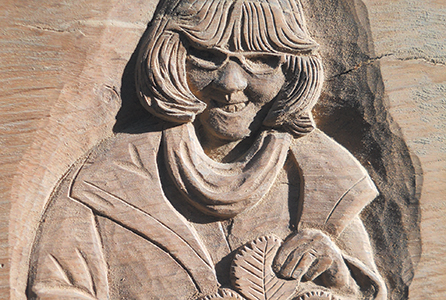
Produced by Alistair Park, this portrait of botanist and poet Libby Houston features on a carved bench in Bristol
“It’s my opinion that traditional techniques certainly have a place in modern sign-making, but I’m not a purist and am happy to use more modern technology if it will do a particular job more quickly and efficiently. Even ‘traditional’ carvers will, in my experience, happily use machines to cut and size boards.”

It’s my opinion that traditional techniques certainly have a place in modern sign-making”
With this, Park speaks of his admiration for his Dremel multi-tool, a modern, handheld device he uses for work. However, at the same time, Park says that the traditional tools he uses are more adaptable when working with certain timbers.
He explains: “Designs can be rearranged slightly whilst the carving is going on, to allow features of the wood to be brought out or hidden. Lettering styles can be changed quickly and immediately to work more effectively in a design, in a way that would perhaps be quite complicated or even impossible to do using computer design. The precise and polished cut made using a sharp gouge wielded by experienced hands is also something that machines can’t yet copy.
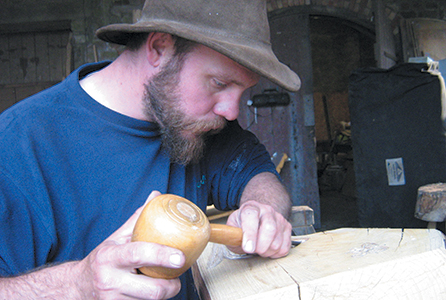
Alistair Park is a self-employed and self-taught woodcarver who has been running a successful, traditional-based business for 23 years. His work spans many sectors and applications
“I feel that hand-carved work has a vitality to it that computer-generated laser cut or CNC work cannot yet replicate. A computer-generated product can be spotted straightaway. That doesn’t mean that they are inferior necessarily, just that they are more suited to certain jobs and less to others.”
Park leads on from this to say that while modern techniques and technologies can take on work that was once only possible by hand, this work will simply not have the same spirit as products produced by skilled carvers, who have built up their own techniques through years or practice. He says there is a certain amount of satisfaction that both the sign-maker and customer will take from the final product.
“I think that certain branches of woodcarving will always require skilled hand carvers: restoration work, for example,” Park says, adding: “Whether they persist in sign carving will really depend on fashion and taste; whether customers will pay for the service provided by those using traditional methods.
“Of course, the less people there are using those traditional techniques now, the less skilled people there will be to teach them in the future.”
Park will offer visitors to Signlink Live this year an insight into his business and way of operating, showcasing not only his immense carving talents, but also just how far this traditional production method can go, and the many applications it can help to create.
With this in mind, Park goes on to say: “I will be appearing at SignLink Live this year and will be demonstrating woodcarving using traditional hand tools. I’m not going to say what I’ll be carving yet, come and say hello and find out.”
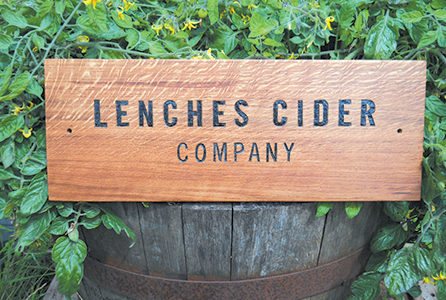
Alistair Park will be one of a number of traditional sign-makers showing off their skills at the Craftsman’s Corner area of Signlink Live this year
Likewise, Peter Millichamp, proprietor of PKM Signs, will be showcasing the beauty and visual impact of gold-leaf gilding.
“I’ve been in business in the sign industry for 35 years, producing traditional hand painted boards, posters, and gold leaf work. Moving with the times, my main sign business embraced computers and digital print, but the grounding in ‘traditional’ work pushed through in terms of my creativity and design style,” explains Millichamp.
He adds: “I continue with all aspects of sign work and teaching, but traditional is coming back mainly in the larger city areas, although there are many sign-writers all over the country still hand painting.
“A key benefit for hand-made signs is the cost might be lower for the customer compared to a proper built-up sign, but the man hours to make it is higher, so you actually ‘make’ more from a hand painted job. Hand produced work has a ‘feel’ that can been seen and felt. It’s the little tweaks and imperfections that make it standout against sterile perfect computer cut vinyls.”
Millichamp concludes: “Another reason that traditional signage has remained current, for instance, is that gold leaf cannot be replicated with the same eye appeal and lustre using digital technology.

Peter Millichamp will be running live demonstrations and training on gold-leaf gilding for the duration of Signlink Live
“I’ll be working on several ‘sample’ glass pieces with gold leaf and painted techniques for Signlink Live, and there will be an opportunity to try the technique and purchase books and gilding tools.”
Character and warmth
Also set to feature in the Craftsman’s Corner at Signlink Live this year is Neil Horne of The Pub Sign Company, which offers services ranging from traditional sign-writing, pictorials and three-dimensional village signs, through to logo design, airbrush art, caricatures, and watercolour portraits.
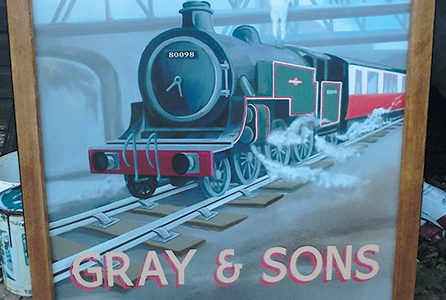
The Pub Sign Company offers services such as traditional sign-writing, pictorials, three-dimensional village signs, logo design, airbrush art, caricatures, and watercolour portraits
Speaking about his time in the industry, Horne says: “I started in sign-writing before the computer was used. While technology has developed the industry beyond recognition, it has also been responsible for diminishing traditional skills.
“I use the computer everyday; as a tool it is invaluable, but I also want to keep traditional skills alive. Anything created by hand has a character and warmth a computer can’t recreate—a knowledge of letter forms and artistic processes increases our appreciation and understanding of creating stunning visual images.

Anything created by hand has a character and warmth a computer can’t recreate”
“There is something very satisfying about creating something by hand. If you’ve taken the time to learn a skill, it would be a shame to waste it.”

There is something very satisfying about creating something by hand. If you’ve taken the time to learn a skill, it would be a shame to waste it”
Horne goes on to say that although he acknowledges there has been something of a “reaction” to the mass-produced digital sign, and praises the work of those in this sector, some customers find that the more ‘traditional’ look is what they are after from their sign.
The vintage look is something that has become popular in various industries in recent years—weddings, fashion, and interior design to name but a few—but, according to Horne, this trend has also extended to the sign-making sector, which means companies and sole-traders like himself have benefitted.
Horne expands: “There are people producing some great work in the modern field but some clients have begun to appreciate the hand-painted look. It’s all about appropriate images; in some places, a modern sign works, and other areas a hand-crafted sign is better. Clients still need the option.”
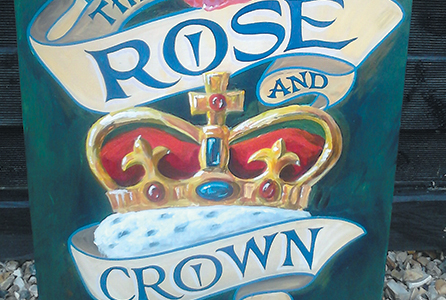
Neil Horne of The Pub Sign Company says although the industry is capable of producing impressive applications with digital technology, sometimes the traditional look can be just as effective
With this in mind, Horne draws attention to the Craftsman’s Corner at Signlink Live, where he will be working alongside various other sign-makers to showcase not only their skills in this area, but how this type signage can offer solutions to even the most modern of companies.
Horne says: “Visitors will see some pretty talented people producing some great stuff. I’m going to be painting some pictorials that hopefully people will like. You will be able to see dedicated craftsmen doing what they do best.
“We will have all the tools on hand so everyone can see how it’s done. You don’t have to be an artist to do this stuff, anyone can learn. Come along and give it a try.”
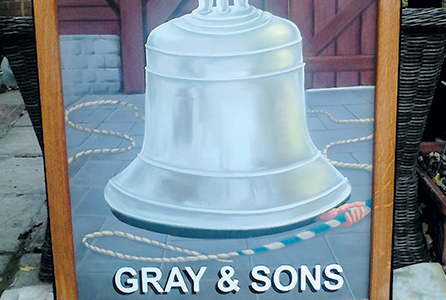
A traditional-focused professional for a number of years, Horne says there is “something very satisfying about creating something by hand"
From this small collection of sign-makers, it is clear to see that traditional work still has a major role to play in the modern industry. Although modern kit and techniques may allow companies to take on projects that were previously not possible, the traditional way of working offers something of a rustic result that often leaves a lasting impression on the end customer.
To find out more about these techniques and technologies, drop in on the Craftsman’s Corner at Signlink Live this year. The new event has been designed specifically for the sign-making market, with a major lean towards the UK in particular.
Although many of the visitors that pass through the door will be looking forward to seeing how manufacturers and suppliers are pushing the boundaries with new kit and technologies, the Craftsman’s Corner will demonstrate that you can more than compete in the modern market with a more traditional approach.
Signlink Live takes place from October 11th to 13th at the International Centre in Telford, a town known locally as the ‘birthplace of industry’. And with the show set to pay tribute to the creative past of sign-making, this approach will put the event in line with this tagline.
O Factoid: The debut edition of Signlink Live will take place from October 11th to 13th at the International Centre in Telford. O
For more information on the Craftsman’s Corner and learn more about how you can register to attend the inaugural edition of Signlink Live this year, visit the event’s official website: signlinklive.co.uk.
Your text here...